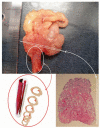The Translational Role of Animal Models for Estrogen-Related Functional Bladder Outlet Obstruction and Prostatic Inflammation
- PMID: 35202312
- PMCID: PMC8877003
- DOI: 10.3390/vetsci9020060
The Translational Role of Animal Models for Estrogen-Related Functional Bladder Outlet Obstruction and Prostatic Inflammation
Abstract
The prevalence of LUTS and prostatic diseases increases with age both in humans and companion animals, suggesting that a common underlying cause of these conditions may be age-associated alterations in the balance of sex hormones. The symptoms are present with different and variable micturition dysfunctions and can be assigned to different clinical conditions including bladder outlet obstruction (BOO). LUTS may also be linked to chronic non-bacterial prostatitis/chronic pelvic pain syndrome (CP/CPPS), but the relationship between these conditions is unknown. This review summarizes the preclinical data that supports a role for excessive estrogen action in the development of obstructive voiding and nonbacterial prostatic inflammation. Preclinical studies that are emphasized in this review have unequivocally indicated that estrogens can induce functional and structural changes resembling those seen in human diseases. Recognizing excessive estrogen action as a possible hormonal basis for the effects observed at multiple sites in the LUT may inspire the development of innovative treatment options for human and animal patients with LUTS associated with functional BOO and CP/CPPS.
Keywords: animal models; bladder outlet obstruction; estradiol to testosterone ratio; lower urinary tract symptoms; prostatic inflammation.
Conflict of interest statement
The authors declare no conflict of interest.
Figures



Similar articles
-
Multidisciplinary approach to prostatitis.Arch Ital Urol Androl. 2019 Jan 18;90(4):227-248. doi: 10.4081/aiua.2018.4.227. Arch Ital Urol Androl. 2019. PMID: 30655633
-
Estrogens and bladder outlet obstruction.J Steroid Biochem Mol Biol. 2010 Feb 28;118(4-5):257-63. doi: 10.1016/j.jsbmb.2009.10.014. Epub 2009 Nov 10. J Steroid Biochem Mol Biol. 2010. PMID: 19900549 Review.
-
Can Botulinum Toxin A Still Have a Role in Treatment of Lower Urinary Tract Symptoms/Benign Prostatic Hyperplasia Through Inhibition of Chronic Prostatic Inflammation?Toxins (Basel). 2019 Sep 19;11(9):547. doi: 10.3390/toxins11090547. Toxins (Basel). 2019. PMID: 31546892 Free PMC article. Review.
-
Testosterone and 17β-estradiol induce glandular prostatic growth, bladder outlet obstruction, and voiding dysfunction in male mice.Endocrinology. 2012 Nov;153(11):5556-65. doi: 10.1210/en.2012-1522. Epub 2012 Sep 4. Endocrinology. 2012. PMID: 22948219 Free PMC article.
-
Prostatic inflammation and obstructive voiding in the adult Noble rat: impact of the testosterone to estradiol ratio in serum.Prostate. 2008 Sep 1;68(12):1296-306. doi: 10.1002/pros.20791. Prostate. 2008. PMID: 18500685
Cited by
-
GPER expression prevents estrogen-induced urinary retention in obese mice.J Steroid Biochem Mol Biol. 2024 Nov;244:106607. doi: 10.1016/j.jsbmb.2024.106607. Epub 2024 Aug 27. J Steroid Biochem Mol Biol. 2024. PMID: 39197539
References
-
- MacKenzie K.R., Aning J.J. Managing lower urinary tract symptoms in men. Practitioner. 2016;260:11–16. - PubMed
-
- Gratzke C., Bachmann A., Descazeaud A., Drake M., Madersbacher S., Mamoulakis C., Oelke M., Tikkinen K., Gravas S. EAU Guidelines on the Assessment of Non-neurogenic Male Lower Urinary Tract Symptoms including Benign Prostatic Obstruction. Eur. Urol. 2015;67:1099–1109. doi: 10.1016/j.eururo.2014.12.038. - DOI - PubMed
Publication types
LinkOut - more resources
Full Text Sources
Miscellaneous

